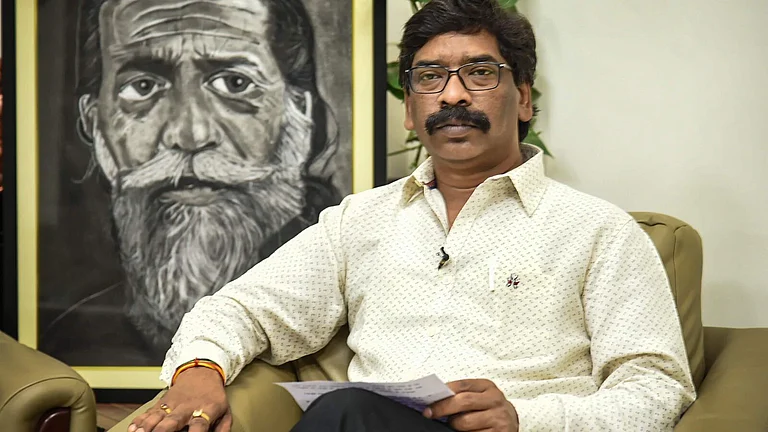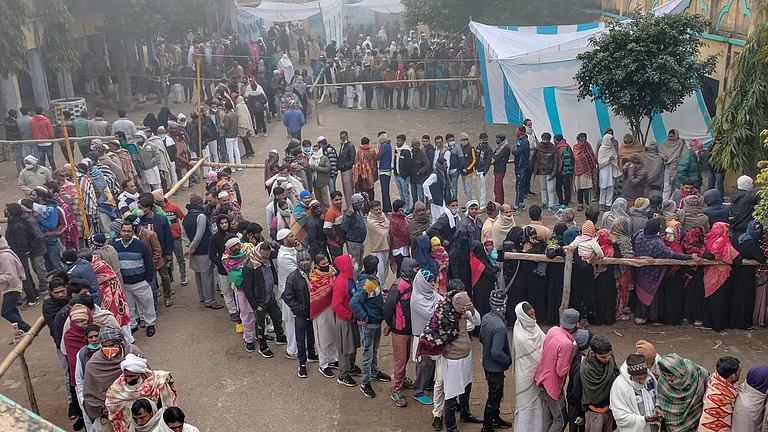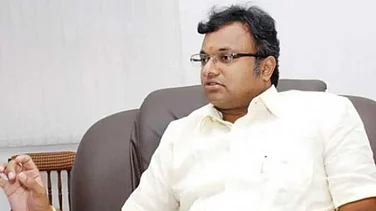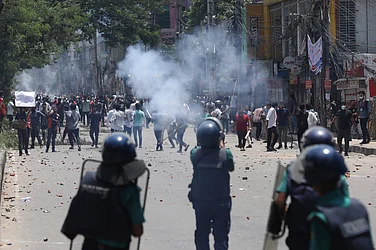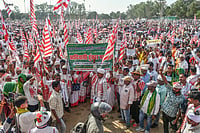A new poster released by the Jharkhand Mukti Morcha (JMM) has lately spawned much political discussion in the state. It features a picture of former Chief Minister Hemant Soren with the slogan “Jharkhand jhukega nahin (Jharkhand will not bow)”. It is being seen in the backdrop of the recent arrest of Soren by the Enforcement Directorate (ED).
Political analysts say that the poster and the slogan, appearing in the run-up to the 2024 general elections, are intended to relay a clear message to the tribals and the indigenous people of the state that Soren continues to be the undisputed leader of the JMM.
In an interview with Outlook, new Jharkhand CM Champai Soren said that the INDIA alliance remains strong in the state. The state has 14 Lok Sabha seats.
He told Outlook, “No doubt, the fight is on now. Our alliance remains strong. Regardless of how many seats the JMM contests, we [the INDIA bloc comprising JMM, Congress, and the Rashtriya Janata Dal] are making a clean sweep in Jharkhand.”
The chief minister further said, “Our leader Hemant Soren will remain the face of the fight whether he is inside [in custody] or outside.”
Throughout the interview, Champai criticised the Bharatiya Janata Party (BJP).
The Seat-Sharing Formula In Jharkhand
Beyond issuing posters and banners, the constituent parties of the INDIA bloc in Jharkhand are currently engaged in discussions over seat-sharing. Before the ED case came to a boil and Hemant Soren was arrested, there were rumours of differences within the alliance, fuelled by competing claims laid by the JMM and Congress leaders on one or two of the Lok Sabha seats.
The ED raids on JMM’s state working president and former CM Hemant Soren also gave rise to speculations that the alliance might fall apart altogether. But political analysts now believe that, far from weakening, the INDIA bloc in Jharkhand has grown stronger in the aftermath of the ED case and Soren’s arrest. They also believe that there will be no rift or vulnerability in the alliance this time over seat-sharing. The new strategy adopted by the alliance for Jharkhand’s 14 Lok Sabha seats differs from that of the last general elections. This time, its formula revolves around a seat-wise assessment of the strength of the candidates and the hold they have on their respective constituencies.
Congress leader and state Finance Minister Rameshwar Oraon told Outlook, “The high command will decide who will contest on how many seats, but the basis of the seat-sharing will be realistic this time. The seats will be allotted taking into account the winnability of candidates. Those who look strong on the ground will get the preference so that we can win the maximum number of seats. The allies may forgo seats for each other, based on the candidates’ strength. I believe that if the JMM has contested a certain seat in the past and the Congress candidate has a stronger hold on it today, the JMM can pass that seat. Similarly, if the JMM has a stronger candidate on a seat previously contested by the Congress, the Congress can give it up.”
Oraon shares the assessment that at present, the INDIA bloc in Jharkhand is potent. Its leaders say that the formula for seat-sharing will be finalised soon. If reports are to be believed, the seat distribution this time may throw up some changes. The Lok Sabha seats of Ranchi, Khunti, Dhanbad, Lohardaga, Hazaribagh, Chaibansa, and Godda may go to the Congress. The JMM is likely to field its candidates from Rajmahal, Dumka, Giridih, and Jamshedpur. The RJD will contest from Palamu. The picture is still unclear regarding Chatra and Koderma. However, the Communist Party of India (Marxist–Leninist) Liberation has repeatedly presented its claim regarding the Koderma seat to the central leadership of the Congress and the JMM.
How Strong Has The Alliance Been In Past?
There have been four Lok Sabha elections in the state since its formation. The United Progressive Alliance (UPA) was formed before the 2004 general elections on the lines of the National Democratic Alliance (NDA). In Jharkhand, the UPA has generally consisted of the Congress, the JMM, and the RJD, with the Congress contesting the lion’s share of the seats.
In the 2004 general elections, the UPA contested 13 seats (Congress six, JMM five, and RJD two), and won 12 of them, with a vote share of 37 per cent. The rival NDA was reduced to only two seats, polling 4 per cent less votes than the UPA.
In the 2009 general elections, the RJD exited the UPA and the alliance disintegrated. The Congress and the JMM contested the polls on nine and five seats respectively and their vote share saw a 13 per cent decline from the previous elections. This was reflected in the seats won by them, which plummeted from 12 to three. The beneficiary of this reversal was the NDA, being victorious on nine constituencies with 29.9 per cent votes.
The UPA shrank further in 2014 and 2019 in the face of the ‘Modi wave’. In 2014, the Congress, the JMM, and the RJD contested nine, four, and one seats respectively. Although their vote percentage remained unchanged, the number of seats won by them reduced to two. The BJP bagged all of the remaining 12 seats. The general elections of 2019 saw the ‘Modi wave’ surge even further. Once again, the BJP-led NDA won 12 seats, with the BJP alone winning 11 of them. There was a tremendous increase in the vote share of the BJP over these successive elections. It grew from 29.9 per cent to 40.7 per cent in 2014 and rocketed to 56 per cent in 2019.
In 2019, the UPA in Jharkhand welcomed a fourth party into its fold: Jharkhand Vikas Morcha (JVM). However, the expanded alliance saw no increase in the number of seats won. The Congress, the JMM, the RJD, and the JVM, contesting on seven, four, one, and two seats respectively, secured only 33 per cent votes and won only two seats.
How Will ‘Double Wave’ Impact Jharkhand?
If we analyse the data from these elections, we find that the UPA put up a strong show on the ground only in 2004. The RJD went its own separate way in 2009. The 2014 and 2019 elections witnessed the UPA parties facing off against each other on some seats.
The state is going to witness its fifth general elections this year and the UPA now exists in a new form as INDIA. The ‘Modi wave’ and the ‘Ram Mandir wave’ pose a double challenge for this alliance. How will it fare in Jharkhand under these circumstances?
Senior journalist Sunny Sharad is of the view that Jharkhand will be largely unaffected by the effects of these two waves.
Sharad tells Outlook, “If you look at the last general elections, their alliance [the UPA] did not appear very strong on the ground because there was mutual conflict among them on many seats. This time, after the ED episode and the arrest of Hemant Soren, everything up to this point indicates that the alliance is going to be impactful on the ground and there is also going to be smooth coordination regarding seat sharing. A second major reason is that after Hemant's arrest, there is a lot of sympathy towards the JMM and Hemant among the tribals and the indigenous people in every village. As far as the Ram Temple is concerned, the demand for the Sarna Dharma Code is an important issue among the tribals in Jharkhand. We do not think that the Ram temple will dominate the tribals here or the Sarna Code.”
According to Sharad, if the INDIA bloc puts up a strong fight on the ground, the BJP has little chance of reprising its previous performance. He points to the absolute majority won by the UPA in the 2019 assembly elections as an example. The JMM, the Congress, and the RJD jointly contested those elections and formed the state government with full majority. The elections were also notable for the fact that for the first time since the formation of Jharkhand, the JMM and the Congress won a record 30 and 16 seats respectively — their best performance till date.
(Translated by Kaushika Draavid)








